Den här månaden driftade Tina Nelson och jag ett webinar som hjälpte B2B-företag att förstå och planera för de förändringar som kommer när marknadens förväntningar förändras. För de av er som vill se detta i videoform kan ni titta på on-demand via länken nedan. För dig som föredrar det skrivna ordet, läs vidare.
Det föränderliga landskapet
B2B-landskapet har förändrats snabbt - men innan du säger "ja, jag vet, en pandemi ...", låt oss prata om en monumental förändring som har pågått sedan innan någon hade sagt "COVID-19".
Generationsskiftet har en allt större inverkan på B2B-företag. Millenniegenerationen har mer än någonsin tagit kontroll över köpbesluten inom B2B och förändrar förväntningarna på leverantörer och tillverkare. Millenniegenerationen utgör nu mer än 50 % av B2B-köparna och 44 % av dem som är involverade i köpprocessen är ensamma beslutsfattare. Denna förändring i teamsammansättningen ger ringar på vattnet i hela verksamheten, men den märks kanske tydligast i de ökande förväntningarna på digitala upplevelser.

Eftersom digitala interaktioner är en självklarhet för den här generationen måste B2B-företag ta reda på hur de kan tillgodose de ökade kraven på enkla och användbara digitala upplevelser.
Personalisering är en av de viktigaste komponenterna i dessa nya digitala förväntningar. McKinsey har identifierat att företag som utmärker sig inom personalisering genererar 40% mer intäkter. År 2021 skulle 72% av användarna av e-handel ENDAST engagera sig i personaliserade meddelanden. I synnerhet i B2B-relationer förväntar sig köpare att bli behandlade som en känd kund. Personaliserade priser, orderhistorik och personliga kreditvillkor är alla exempel på personalisering som B2B-leverantörer har gjort i flera år. Ytterligare produkterbjudanden som dashboards för kunder, personaliserade produktrekommendationer, kuraterade/personaliserade återbeställningslistor, specifika hemsidor per kundtyp, sökresultat som influencers av orderhistorik och prioriterade kategorier baserat på potentiell personalisering tar detta till nästa nivå.
Anpassa för att bygga förtroende i en digital värld
Trots fokus på digitala kundupplevelser är förtroendefulla relationer fortfarande drivkraften i B2B-affärer. På samma sätt som B2C-företag försöker skapa förtroende via varumärket måste B2B-företag bygga förtroende genom meningsfulla kundinteraktioner. Detta är välkänt bland praktiker, men det är alltid bra att bli påmind om grunderna. Här är några ingredienser för att bygga förtroende hos B2B-kunder (från Katie Martell):
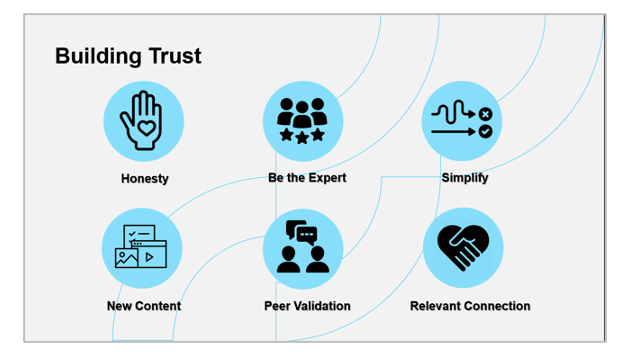
Det här sättet att bygga förtroende som den primära prioriteringen inom B2B står faktiskt inte i konflikt med det digitala. Faktum är att på samma sätt som upplevelsen på kontoret eller i butiken bidrar till kundernas känsla av förtroende, så gör även den digitala kundupplevelsen det. Till exempel är överbelastning av information ett av de vanligaste problemen i dagens näringsliv. Tänk på det här:
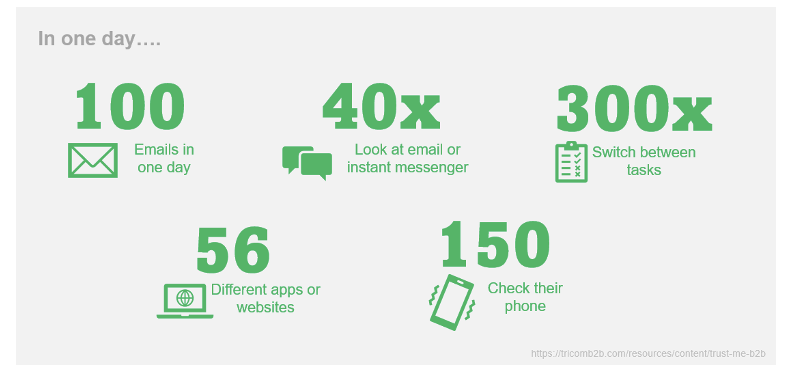
Tänk dig nu att ditt team arbetar proaktivt för att minska de interaktioner som krävs för att komma åt den viktigaste informationen för att fatta köpbeslut. Tror du att dina kunder litar mer på dig? Är det troligt att de kommer till dig med fler av sina frågor eller för att fastställa svåra krav?
På samma sätt handlar inte övergången till mer digitala interaktioner om att ta bort det mänskliga elementet ur ekvationen. Det verkliga skiftet kan snarare ses som en punkt där marknadsföring och försäljning korsar varandra - i pipelinen nedan ser du att de nya interaktionsförväntningarna fortfarande är beroende av säljrepresentanter, men att marknadsföring (och självbetjäning) helt enkelt hamnar längre ner i försäljningstratten.
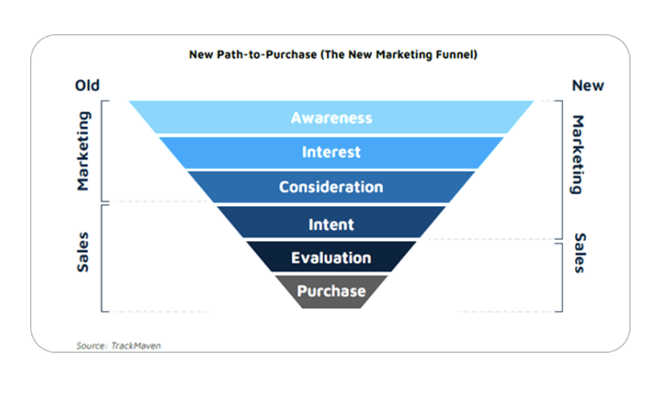
Låt oss titta på konkreta saker du kan göra för att skapa förtroende för din digitala upplevelse.
Bygga förtroende med digitala lösningar: personalisering och UX
Jag upplever att många av våra B2B-kunder känner sig överväldigade när de blir tillsagda att arbeta med "personalisering". Det finns faktiskt ett mycket lättillgängligt sätt att börja tänka på personalisering inom B2B, men det kräver att du slutar likställa "personalisering" med "individualisering". Det finns faktiskt nivåer av personalisering som ett digitalt team kan agera inom: Makrosegmentering, mikrosegmentering och individualisering.

Alla B2B-företag känner redan till sin makrosegmentering - kundtyp, kundstorlek, var kunden befinner sig. På nivån för makrosegmentering kan du överväga personalisering av innehåll, kategorier, kataloger och kampanjer. När du mognar kan du titta på mikrosegmentering, baserat på beteenden. På den här nivån kan du överväga personaliserade arbetsflöden, meddelanden på plats och kampanjer. Det är bara på den översta nivån som du behöver oroa dig för 1 till 1-relationer. På den här nivån kan du tänka på produktrekommendationer, personalisering av sökningar och meddelanden.
Personalisering är tätt kopplad till den övergripande användarupplevelsen. Och B2B-köpare blir alltmer krävande när det gäller en utmärkt UX.

Om ditt team är redo att fokusera på att skapa en mer konsumentliknande upplevelse men inte vet var du ska börja, välj två eller tre av kategorierna nedan och låna bästa praxis från B2C för att förbättra dem.
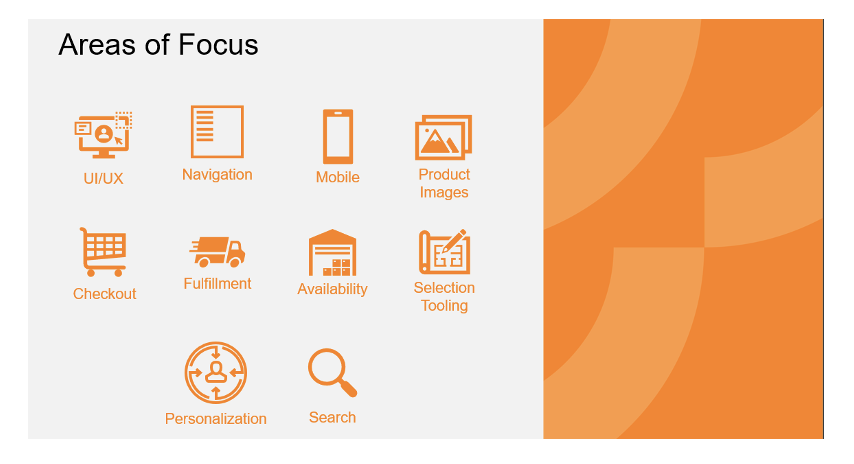
Bygga förtroende med digitalt innehåll och självbetjäning
Att ha rätt innehåll är också avgörande för att bygga förtroende hos dina digitala kunder. Vi vet alla att detta inkluderar korrekt och fullständig produktinformation. Överväg även alternativa former av innehåll:

Förutom varierade former av innehåll är det viktigt att se till att köparna kan gå igenom en stor del av köpupplevelsen med hjälp av självbetjäning. Det handlar om att tillhandahålla rätt information och rätt verktyg vid rätt tidpunkt. Börja med bra produktdata, specifikationsblad, orderstatus, lager, snabbeställning, fakturabetalning osv. Om du vill gå till nästa nivå kan du överväga de här verktygen:
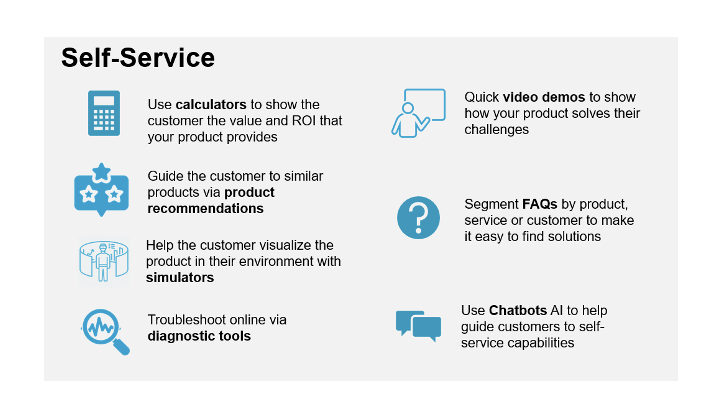
Bygg förtroende med digitala verktyg: möt dem där de är
Det sista rådet vi kan ge är att verkligen bygga upp förtroendet; du måste möta köparna där de är, inte där du föredrar att vara. Detta inkluderar:
- Sociala medier - B2B:s användning av YouTube och Instagram har båda ökat med mer än 30 % på ett enda år. Sociala medier har äntligen nått en brytpunkt för B2B.
- Mobil - Mobilen influencerar nu 40% av alla intäkter för B2B-organisationer. Det kanske inte är din primära kanal, men dina köpare använder sina mobila enheter som en del av processen.
- Sök - Millennials är dubbelt så benägna att upptäcka produkter genom att söka på nätet jämfört med äldre generationer. Med millenniegenerationen i förarsätet blir sökning allt viktigare.
- Röstassistenter - 128 miljoner människor i USA använder nu röstassistenter. Det kanske inte är primetime för B2B ännu, men vi förväntar oss att detta kommer att öka under de närmaste åren.
Att ta med sig
- Millennials blir allt mer involverade i köpbesluten inom B2B och vill interagera mindre med säljrepresentanter och mer online.
- COVID och generationseffekter driver onlineupplevelser till att bli mer B2C-liknande upplevelser.
- Utvärdera din organisation och webbplats och leta efter möjligheter att bygga förtroende.
- Var personaliserade och relevanta med kommunikation och innehåll. Leta efter möjligheter att förenkla den komplexa köpprocessen och effektivisera det informationsöverflöd som många köpare upplever.
- Möt dina kunder där de är - genom personalisering och UX, innehåll och självbetjäning, sociala medier, mobila medier och söktjänster.
Om du vill se all denna data och mer, kan du fortfarande titta på webinaret genom att besöka:
- Last modified:2025-04-26 00:15:27

